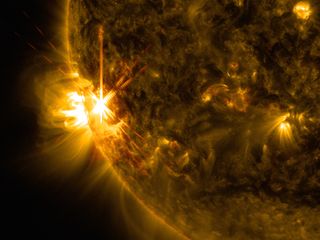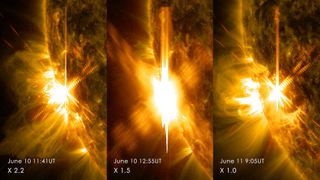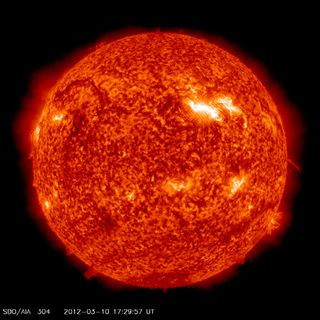Sun Erupts with 3rd Huge Solar Flare in 2 Days (Video)
The sun is hitting its stride. Earth's closest star shot off yet another powerful solar flare today (June 11) after producing a pair of major solar storms Tuesday.

The X1-class flare reached its peak at 5:06 a.m. EDT (0906 GMT) and came from Region 2087 near the southeastern limb of the sun's disk, the same region of the star that produced the two powerful solar flares yesterday. NASA captured an amazing video of the X1 solar flare using its space-based Solar Dynamics Observatory.
Today's solar tempest did cause a brief radio blackout on Earth, but officials with the U.S. Space Weather Prediction Center based in Boulder, Colorado, don't think that the flare has an associated coronal mass ejection — a burst of hot plasma sent out from the sun during some solar flares. [See photos of the biggest solar flares in 2014]

While officials with the SWPC didn't initially think that Tuesday's flares produced a coronal mass ejection — a burst of plasma associated with some solar flares — later analysis shows that the flares did produced two CMEs. The first solar flare produced a relatively small CME, with the second merging with it shortly after, according to astronomer Tony Phillips at spaceweather.com.
The CME is expected to give Earth a glancing blow, when it reaches our part of the solar system Friday (June 13). It's possible that the incoming CME could create polar geomagnetic storms, according to Phillips.
The sun is in the active phase of its 11-year solar cycle, called Solar Cycle 24. NASA officials now think the sun is in its maximum, which they have dubbed the "mini max." Although the sun's activity is on the upswing, this solar max is still quite weak by comparison to other solar maximums on record, NASA officials have said. Scientists expected that the solar maximum (the peak in the sun's activity for the cycle) would occur in 2013.
"It's back," Dean Pesnell, of NASA's Goddard Space Flight Center, said in a NASA statement Tuesday (June 10) on the sun's weather cycle. "Solar max has arrived."
Get the Space.com Newsletter
Breaking space news, the latest updates on rocket launches, skywatching events and more!

The sun also shoots out other, less powerful classes of solar flares. M-class flares can produce incredible auroras, and our nearest star also emits weaker C-class flares.
NASA has a fleet of sun-monitoring satellites in orbit today. The Solar Dynamics Observatory, the space agency's twin STEREO probes and the joint U.S.-European SOHO spacecraft all keep watch on the sun from space.
Follow Miriam Kramer @mirikramer and Google+. Follow us @Spacedotcom, Facebookand Google+. Original article on Space.com.
Join our Space Forums to keep talking space on the latest missions, night sky and more! And if you have a news tip, correction or comment, let us know at: community@space.com.

Miriam Kramer joined Space.com as a Staff Writer in December 2012. Since then, she has floated in weightlessness on a zero-gravity flight, felt the pull of 4-Gs in a trainer aircraft and watched rockets soar into space from Florida and Virginia. She also served as Space.com's lead space entertainment reporter, and enjoys all aspects of space news, astronomy and commercial spaceflight. Miriam has also presented space stories during live interviews with Fox News and other TV and radio outlets. She originally hails from Knoxville, Tennessee where she and her family would take trips to dark spots on the outskirts of town to watch meteor showers every year. She loves to travel and one day hopes to see the northern lights in person. Miriam is currently a space reporter with Axios, writing the Axios Space newsletter. You can follow Miriam on Twitter.